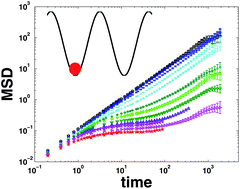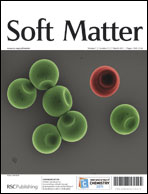Dynamics of dilute colloidal suspensions in modulated potentials
Abstract
The dynamics of dilute suspensions of charged polystyrene spheres have been studied in a sinusoidal potential. We investigated experimentally and theoretically the effect of the wavelength and amplitude of this potential as well as the particle size on the mean square displacement, the distribution of displacements and the non-Gaussian parameter. These properties scale with the radius of the particles and the magnitude of the wavevector of the potential as expected from a dimensional analysis. In contrast, they show a non-trivial dependence on the amplitude of the potential, which determines the barrier height encountered in long-distance motions and also the intermediate-time dynamics in the potential well. The periodic potential leads to particle dynamics which resemble the self dynamics of various systems approaching their glass transition. In particular, we found that the time-dependent mean square displacements determined in our system are surprisingly close to the ones in a quasi two-dimensional colloidal supercooled liquid. In this case, the role of the colloid volume fraction is played by the amplitude of the potential. The similarity of the mean square displacements is particularly striking since an individual colloidal particle in a periodic potential represents a considerably simpler situation than a highly concentrated multi-particle system.


 Please wait while we load your content...
Please wait while we load your content...